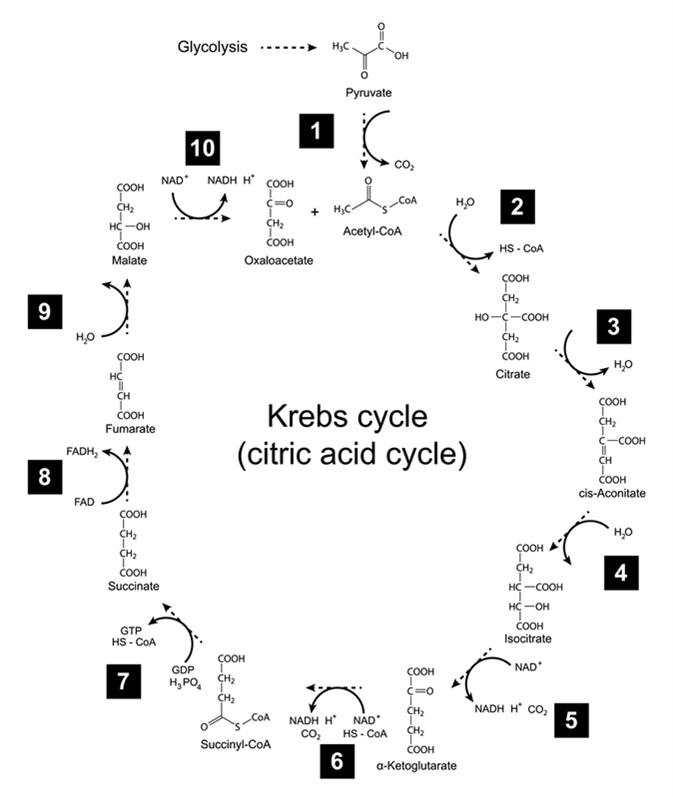The Krebs cycle is named after its discoverer, Hans Krebs. It is also known as the citric acid cycle or the tricarboxylic acid cycle. It is a series of chemical reactions required for cellular respiration; it involves redox, dehydration, hydration, and decarboxylation reactions that produce ATP (adenosine triphosphate), a coenzyme energy carrier for cells. The waste product, in the form of carbon dioxide, is also produced as well as further sets of reactants used to regenerate the original reaction.
Glycolysis, Pyruvate Oxidation and the Krebs Cycle
Glycolysis, the process of splitting a six-carbon glucose molecule into two three-carbon pyruvate molecules, is linked to the Krebs cycle. For each glucose molecule respired, the cycle reactions occur twice as two pyruvic acid molecules are formed. Glycolysis is an anaerobic reaction which occurs in the cytoplasm of the cell. The rest of the reactions in cellular respiration are aerobic, therefore requiring oxygen, and occur in the mitochondria of the cell. The three-carbon pyruvic acid molecules are converted to a two-carbon molecule attached to Coenzyme A, called acetyl CoA, via the process of pyruvate oxidation. It is the product, acetyl CoA, which enters the Krebs cycle.

Chemical scheme of Krebs cycle - tricarboxylic acid (citric) cycle, 2d illustration. Image Credit: Chromatos / Shutterstock
Steps in the Krebs Cycle
The Krebs cycle is a closed-loop set of reactions in eight steps:
- The two-carbon acetyl CoA is combined with a four-carbon oxaloacetic acid and hydrolyzed to produce a six-carbon compound called citric acid or citrate.
- Citrate is then converted into isocitrate, a six-carbon isomer of citrate by dehydrating and then hydrating the molecule to reshuffle its structure.
- Isocitrate is oxidized and decarboxylation occurs with a carbon dioxide molecule released. The coenzyme NAD+ is reduced to form another dinucleotide, NADH. With the removal of the carbon molecule, the five-carbon molecule α-ketoglutarate is produced.
- The α-ketoglutarate molecule is oxidized, NAD+ is reduced to form NADH and another carbon molecule is released. The four-carbon molecule produced combines with Coenzyme A, forming the unstable succinyl CoA compound.
- A phosphate group replaces the Coenzyme A in succinyl CoA, which is then transferred to ADP (adenosine diphosphate) to form ATP. The transference of the phosphate groups occurs between GDP (guanosine diphosphate) to form GTP (guanosine triphosphate) in some cells. The four-carbon molecule that remains is called succinate.
The remaining steps of the Krebs cycle regenerate oxaloacetic acid from succinate:
- Succinate is oxidized to form the four-carbon molecule called fumerate. The electron carrier FAD (flavin adenine dinucleotide), is reduced to FADH2 by the transference of two hydrogen atoms.
- Fumerate is converted into the four-carbon molecule called malate by the addition of a water molecule.
- The original reactant oxaloacetic acid is regenerated by the oxidation of malate. The coenzyme NAD (nicotinamide adenine dinucleotide) is reduced to NADH by the transference of one hydrogen atom.
Products and Functions of the Krebs Cycle
For one cycle, two molecules of carbon, three molecules of NADH, one molecule of FADH2 and one molecule of ATP or GTP are produced. Each glucose molecule produces two molecules of acetyl CoA, enough for two cycles. These products can be multiplied by two to produce the per-glucose yield. Though only one ATP (or GTP) is produced directly per cycle, the products NADH and FADH2, can produce ATP (or GTP) in a further process of cellular respiration called oxidative phosphorylation.
krebs cycle mitochondria
The main function of the Krebs cycle is to produce energy, stored and transported as ATP or GTP. The cycle is also central to other biosynthetic reactions where the intermediates produced are required to make other molecules, such as amino acids, nucleotide bases and cholesterol. The Krebs cycle is found in all cells that use oxygen. Combined with the process of oxidative phosphorylation, the Krebs cycle produces the majority of energy used by aerobic cells with the percentage energy provided for humans being greater than 95%.
Terminology
- Redox: The combined name of the complimentary oxidation and reduction processes. Oxidation is the gaining of oxygen. Reduction is the loss of oxygen.
- Hydration: The addition of a water molecule.
- Dehydration: The subtraction of a water molecule.
- Decarboxylation: The removal of a carboxyl group and the release of a carbon dioxide molecule.
- Isomer: Two compounds with the same formula but a different structural arrangement of atoms.
Sources:
- Berg JM, Tymoczko JL, Stryer L. Biochemistry. 5th edition. New York: W H Freeman; 2002. Chapter 17, The Citric Acid Cycle. https://www.ncbi.nlm.nih.gov/
- Berg JM, Tymoczko JL, Stryer L. Biochemistry. 5th edition. New York: W H Freeman; 2002. Section 17.1, The Citric Acid Cycle Oxidizes Two-Carbon Units. https://www.ncbi.nlm.nih.gov/books/NBK22427/
- RSCB Protein Data Bank- Molecule of the Month: Citric Acid Cycle. http://pdb101.rcsb.org/motm/154
- www.khanacademy.org/.../the-citric-acid-cycle
Further Reading